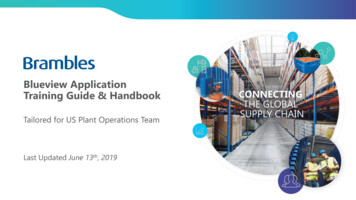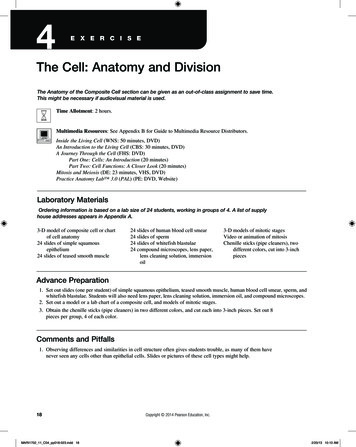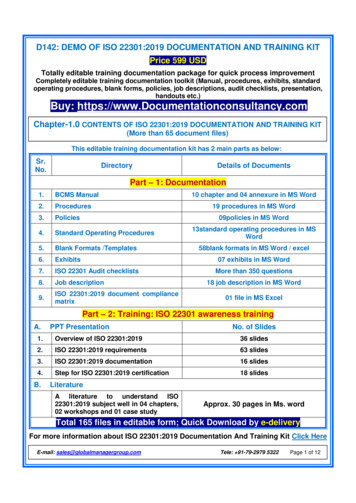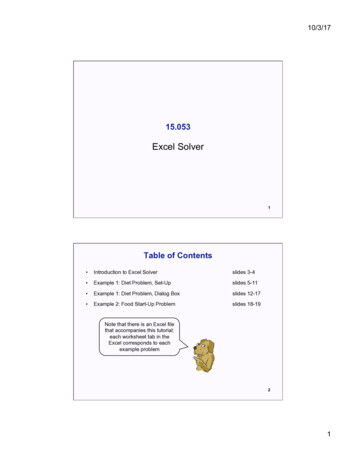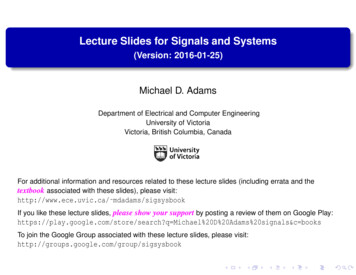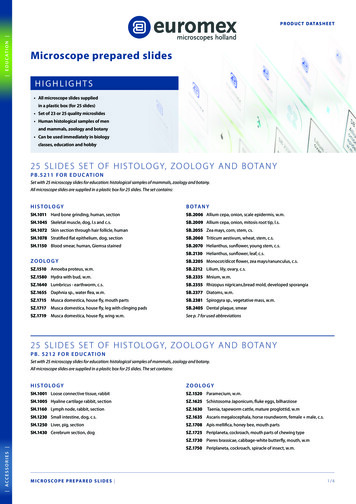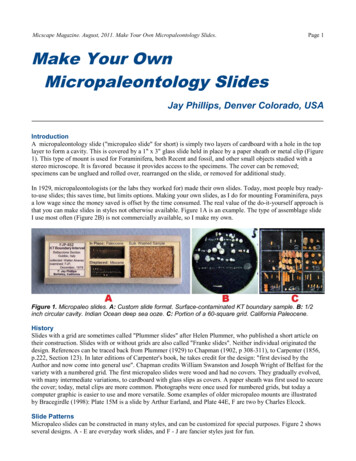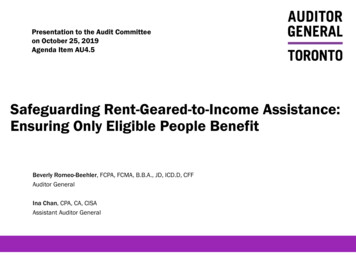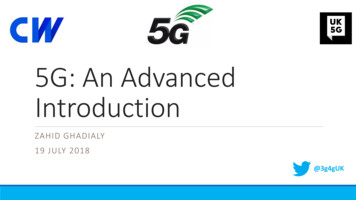
Transcription
5G: An AdvancedIntroductionZAHID GHADIALY19 JULY 2018@3g4gUK
Legal DisclaimerThis presentation is intended to stimulate discussion on some of the exciting current and futuredevelopments in digital communications technology and networks. It also contains someforward looking statements, research and speculation that may never become part of standards.It strives to provide the latest and most correct information. Due to the vastness of standards,constant change and revision, it is possible that the following information may not be entirely upto date or correct. E&OE.There are references to information in public domain (books, websites, standard documents,etc.) in this material. Attempt has been made to give credit to all such references whereverpossible. The original copyright holders retain the copyright to their material.It would not be prudent to make any financial or investment decisions based on thispresentation. 3G4G
Agenda: Session 1 Mobile Technology GenerationsWhy is 5G called 5G?ITU and IMT-20205G StandardsSpectrum for 5GState of market, trials, etc.5G Motivation and Use cases 3G4G
Different 2G SystemsD-AMPS – Digital AMPS 1993 – 2009 IS-54 & IS-136 TDMA based technology cdmaOne1995 – 2001Championed by QualcommIS-95CDMA based technologySupplanted by CDMA2000(3G) technologyGSM – Global System for Mobile communications Originally ‘Groupe Spécial Mobile’ 1991 - present First deployed in Finland, Dec. 1991 Launched in UK, 1993 Most popular 2G system in use worldwide Uses mainly 900MHz or 1800MHz Originally designed for voice only SMS was commercially launched in 1995 Data was supported using High-Speed, CircuitSwitched Data (HSCSD) giving max data rates of57.6Kbps 3G4GPDC – Personal Digital Cellular 1993 – 2012
GSM – Most popular 2G system 3G4G
International Mobile Telecommunications-2000(IMT-2000) 3G4G
IMT-2000 TechnologiesIMT-2000 Terrestrial Radio InterfacesPaired SpectrumUnpaired SpectrumW-CDMA(UTRA-FDD)CDMA2000TD-CDMA(UTRA-TDD) TD-SCDMACDMAUWC -136(EDGE)TDMA 3G4GDECTFDMA
Third Generation (3 ‘G’) Mobile System CDMA2000 EV-DOEvolution Data OptimizedFurther evolved to EV-DO Rev. A EV-DO Rev. BUniversal MobileTelecommunications System(UMTS) Based on Wideband CDMA(WCDMA) Uses FDD Foundation of 3G systemsworldwide, except somenetworks 3G4GTime Division Synchronous codedivision multiple access(TD-SCDMA) Designed especially for China Used by only 1 operator,‘China Mobile’ Based on Narrowband TDD
3 ‘G’ Evolution Rel-99: DL 384Kbps, UL 384Kbps Rel-5: HSDPA (3.5G) – DL 14Mbps, UL 384Kbps Rel-6: HSUPA (3.6G) – DL 14Mbps, UL 5.75Mbps Rel-7: HSPA (3.7G) – DL 28Mbps, UL 11.52Mbps Rel-8: HSPA (3.75G) – DL 42Mbps, UL 11.52Mbps Rel-9: HSPA (3.8G) – DL 84Mbps, UL 23Mbps Rel-10: HSPA (3.8G) – DL 168Mbps, UL 23Mbps Rel-11: HSPA (3.85G) – DL 672Mbps, UL 70Mbps 3G4G
Fourth Generation (4 ‘G’) Mobile SystemNotice the peak datarate 3G / UMTS IMT-2000 HSPA/HSPA Enhanced IMT-2000 4G / LTE IMT-Advanced 3G4G
4G ClaimsSource: TechRepublic 3G4G
IMT-Advanced and 4G Technologies 3G4G
LTE: One Technology to Unify Them AllLTE / LTE-A(FDD – TDD)1xEV-DO: Enhanced Voice-Data OptimizedCDMA ONE:Code Division Multiple Access OneEDGE:Enhanced Data rates for GSM EvolutioneHRPD: Enhanced High Rate Packet DataGPRS:General Packet Radio ServiceGSM:Global System for Mobile CommunicationsHSPA:High Speed Packet AccessHSPA : High Speed Packet Access PlusOFDMA: Orthogonal Frequency Division Multiple AccessSCDMA: Synchronous CDMATD:Time DivisionTD-SOFDMATD Scalable OFDMAUMTS: Universal Mobile Telecommunication System3GPP 3GPP2 3G4G
4G Evolution3.9G? 4G?4G? 4G ? Advanced 4G?4.5G? 3G4G4.5G? 4.9G? 5G?
5G Confusion?Source: TeleGeographySource: The Register 3G4G
5G IMT-2020 3G4G
Focus area for different technology generationsSpeed / Throughput2G Focus areaVoice SMS3G Focus area4G Focus area5G Focus areaDataConnection DensityLatency / Delay 3G4G
Focus area for different technology generationsSpeed / Throughput2G, 3G, 4G5GDataConnection DensityLatency / Delay 3G4G
Mobile Technology Evolution1GAnalog2GVoice only, Limitedcoverage andmobility. Example:AMPSDigital3GImproved voice,security, coverage.SMS, data. ExampleGSM, CDMAMobile Data4GHigher data rates,smartphones,better voice.Example: HSPA /HSPA MobileBroadband5GHigh speed data,bettersmartphones.Example: LTE / LTEAeMBB, mMTC,URLLC1980199020002010 3G4GEven higher speeds,ultra-reliable, lowlatency, highconnection density2020
Comparison of 2G, 3G, 4G & 5G technologiesConnection Speed, Latency & Density Comparison2G3G4G5GExample only.Not according to scaleSpeedLatencyConnection Density 3G4G
Mobile Generation By Standards1G3G2G4G5G6GLTEIn some E-A ProHSPAUWC-136HSPA In some country6G XCDMA2000IS-95 (cdmaOne)5G NR eLTE5G XEVDO6G XThere is constant battle between standards, technology and marketing with regards to naming for different generations.Marketing generally wins!Based on Slides by Seizo Onoe, Chief Technology Architect at NTT DOCOMO, Inc. 3G4G
4G vs 5G 3G4G
5G RequirementsOptimize forconnectionnumbersOptimize fordata rateOptimize fordelayImage Source: 5G-From Research to Standardisation - Bernard Barani European Commission, Globecom2014 3G4G
5G (IMT-2020) RequirementseMBB (enhanced Mobile Broadband) – Capacity EnhancementITU-R IMT-2020 requirementsGigabytes in a secondSmart Homes3D video 4K screensSmart-city camerasWork and play in the cloudAugmented/Virtual realityVoiceIndustrial and vehicular automationSensor NetworkMission critical broadbandSensorSelf-driving carURLLC (Ultra-reliable and Low-latency communications) –High reliability, Low latencymMTC (massive Machine Type Communications) –Massive connectivity 3G4G
5G High Level Requirements and Wish List100 Mbps 10 GbpsWhenever neededPeak data rates10000 x100 xMore traffic than 4GMore devices than 4GM2MURUltra low costUltra-Reliable10 yearsbattery life 1 msLow latency onradio interface 3G4G
Evolution of Speeds: Fixed, Wi-Fi & Mobile 3G4G
3G4G
The Radio Spectrum is part of spectrum from 3Hz to 3000GHz (3 THz) 3G4G
Wi-Fi Spectrum around the world 3G4G
Bandwidth in mobile networksThe simplest way to understand bandwidth is to think of them as pipes. Thefatter the pipe, the more the bandwidth 3G4G
Latency & JitterLatency is generally defined as the time it takes for a source to send a packetof data to a receiver. In simple terms, half of Ping time. This is also referred toas one way latency.Sometimes the term Round trip latency or round trip time (RTT) is also usedto define latency. This is the same as ping time.Jitter is defined as the variation in the delay (or latency) of received packets.It is also referred to as ‘delay jitter’. 3G4G
AExplaining Latency vs BandwidthBBandwidth is oftenreferred to as ameasure of capacity.CWhile Latency is ameasure of delay.21 3G4G
TDD v/s FDDTransmitterTransmitterUEUEFrequency Division Duplex (FDD)Time Division Duplex (TDD)Simpler to implementImplementation is complexSimultaneous downlink and uplinktransmissionOnly uplink (UL) or downlink (DL) atany timeNo need for synchronisation hencesimpler implementationNeed for synchronisation within thewhole networkNeeds paired spectrumNo need for paired spectrumUL/DL ratio is fixed.Number of UL/DL ratio ischangeable 3G4G
UK: Frequency Allocation for mobile – July 2017Source: Ofcom 3G4G
UK: 2100MHz (2.1GHz) 3G4G
UK: 2600 MHz (2.6 GHz) 3G4G
UK: 1800 MHz 3G4G
UK: 2.3 and 3.4 GHz spectrum auction ResultsSource: Ofcom 3G4G
Importance of Frequency selectionHigher frequencymeans fasterdecayLower frequency meansmore number of users in agiven cell2.1GHz900MHzHigher frequency getsreflected from walls andhave poor penetrationLower frequency getsattenuated from walls butstill penetrates 3G4G
5G Spectrum 3G4G
5G: Multiple Layers for multiple needsCoverage LayerSub-1GHzCapacity Layer1GHz – 6GHzHigh Throughput Layers6GHz – 100GHz 3G4G
Types of Small CellsRural 3G4G
Mobile Towers or Macrocells
Examples of Small Cells 3G4G
End-to-end (E2E) LatencyEnd-to-end (E2E) latency: the time that takes to transfer a given piece ofinformation from a source to a destination, measured at the communicationinterface, from the moment it is transmitted by the source to the moment itis successfully received at the destination. 3G4G
5G Latency Requirements - Industry TargetsNGMN 5G Requirements 5G E2E Latency (eMBB) 10ms (i.e. RTT from UE-Application-UE) 5G E2E Latency (URLLC) 1ms (i.e. RTT from UE-Application-UE – or just UE-UE)In both cases, the values are defined as capabilities that should be supported by the 5G System.GSMA 5G Requirements 5G E2E Latency 1ms (again, defined as a capability target, not as a universal requirement)ITU-R IMT-2020 Requirements eMBB User Plane Latency (one-way) 4ms [radio network contribution] URLLC User Plane Latency (one-way) 1ms [radio network contribution] Control Plane Latency 20ms (10ms target) [UE transition from Idle to Active via network]Low Latency Use Case Requirements (various sources) Virtual Reality & Augmented Reality: 7-12ms Tactile Internet (e.g. Remote Surgery, Remote Diagnosis, Remote Sales): 10ms Vehicle-to-Vehicle (Co-operative Driving, Platooning, Collision Avoidance): 10ms Manufacturing & Robotic Control / Safety Systems: 1-10ms 3G4GSource: Andy Sutton
State of market, trials, etc. June 2018: Vodafone to kick off UK 5G trials in seven UK cities ahead of 2020launch June 2018: EE confirms October 2018 UK launch date for first 5G live trials June 2018: Elisa claims "first in world to launch commercial 5G" May 2018: Three Middle East Operators launch 'World's First' 5G Networks –Ooredoo, Qatar, STC, Saudi Arabia and Etisalat, UAE May 2018: Verizon CEO: 5G coming end of 2018; expect competition on capability,not price March 2018: KT, South Korea announces launch of 5G Network in 2019 Feb 2018: T-Mobile USA announces that they will launch 5G in 12 cities by end of2018 using 600 MHz Jan 2018: AT&T to Launch Mobile 5G in 2018 3G4G
NGMN 5G Use Cases ExampleBroadband accessin dense areasBroadband accesseverywhere50 MBPSEVERYWHEREPERVASIVE VIDEOHigher usermobilityHIGH SPEEDTRAINMassive Internetof CES50Extreme unicationsNATURALDISASTER5G use case families and related examples 3G4G
NGMN: 5G Families, Categories & Use CasesFamiliesBroadbandaccess indense areaBroadbandaccesseverywhereHigh usermobilityMassiveInternet ofThingsUse casesCategories Pervasive videoOperator cloud servicesDense urban cloud servicesIndoor ultra-high broadband access Smart OfficeBroadband access in a crowd HD video/photo sharing instadium/open-air gathering 50 Mbps everywhere Ultra-low cost networks High speed trainMoving Hot SpotsRemote computing 3D Connectivity: Aircrafts Smart wearables (clothes)Sensor networks Mobile video surveillanceBroadband access in dense area50 Mbps everywhereUltra low-cost broadband access for lowARPU areasMobile broadband in vehiclesAirplanes connectivityMassive low-cost/long-range/low-power MTCBroadband MTC 3G4G
NGMN: 5G Families, Categories & Use CasesFamiliesUse casesCategoriesExtreme realtime connectionBroadband access in dense area Tactile internetLifelinecommunicationResilience and traffic surge Natural disasterUltra-high reliability & Ultra low latency Automatic traffic control-drivingCollaborative robotsRemote object manipulation –Remote surgery eHealth: Extreme Life CriticalPublic safety3D Connectivity: Drones News and informationBroadcast like services: Local,Regional, NationalUltra-reliablecommunicationUltra-high availability & reliabilityBroadcast likeservicesBroadcast like services 3G4G
Fixed Wireless Access (FWA): 5G-to-the-HomeOne accessantenna perhousehold(indoor oroutdoor) and WiFi distributioninside the homemmWavecmWave and mmWaveradios (possibly withMassive MIMO)mmWaveFiberdistributionpointFeeder routeDistributionUsing mmWave spectrum each 5G base station can reach tens of households, each fittedwith an antenna 3G4GSource: Nokia
5.8 GHz FWA installation ExampleSource: Plum Consulting Whitepaper on FWA 3G4G
Cellular V2X ConceptNB-IoTBackendParkingEdge CloudLTE/5GV2ITraffic /5G V2VLocal SensorsV2X – Vehicle to EverythingV2I – Vehicle to InfrastructureV2P – Vehicle to PedestrianV2V – Vehicle to VehicleV2N – Vehicle to NetworkP2N – Pedestrian to NetworkLTE/5GP2NLTE/5GV2PLTE/5G V2VLocal SensorsLocal Sensors 3G4GVulnerableroad users
5G Connected Car: In-vehicle infotainment5G5GCloud5G5GA dense city center deployment of 5G deliver mobile broadband and infotainment services to customers using public transport 3G4GSource: Nokia
5G Connected StadiumsPit stop viewDrive/carview5GAerial/topviewVIPVR setsTicketsTablets5GWalk on the trackWith 5G, CSPs can offer multiple cameraviews and virtual reality to thousands at amajor sporting eventSource: Nokia 3G4G
5G Autonomous Driving: PlatooningCloud5G5G5G5G5G5G is the most promising enabler of truck platooning in which long convoys of trucks areautomatically governed and require only a single driver in the lead vehicle 3G4GSource: Nokia
Summary of 5G Use CasesHuman to HumanExtremeMobileBroadband(eMBB)Human to MachineUltra-ReliableLow LatencyService(URLLC)Mobile eScaleCommunication(mMTC)VideoMonitoringVirtual Reality/Augmented RealityVideo CallingVirtual MeetingsMachine to MachineSmart Home / Smart CitiesSocialNetworkingPublic SafetyHealth Care ehicle(V2V)Source: 5G Americas 3G4G
Break! Videos (time permitting) 3G4G
Agenda: Session 2 5G Network Architecture5G System (5GS) and 5G Core (5GC)SDN / NFVNetwork SlicingEdge Computing5G New Radio (NR) and RAN ArchitectureMassive MIMO, beamforming, etc.5G Core Architecture5G Deployment Options: Non-Standalone (NSA) and Standalone (SA)5G Resources, including Tutorials and Videos at 3G4G: https://www.3g4g.co.uk/5G/ 3G4G
2G / 3G Mobile Network ArchitectureVoice (PSTN)NetworkCircuit Switched(CS) CoreCoreNetwork(CN)Data (IP)NetworkPacket Switched(PS) CoreBackhaulBaseStationRadioAccessNetwork(RAN)Base StationControllerBase StationControllerCore Network Connects to voice and data networks Provides Security and Authentication Billing / Charging RoamingBackhaul Connects access network with corenetwork Example: Fiber, microwave, satellite,mesh, etc.Access Network Connects devices over the air Allows mobility and handoversBase StationTransmitter/ ReceiverAirInterfaceUser Equipment (UE) 3G4G
4G Mobile Network ArchitectureVoice (PSTN)NetworkCircuit Switched(CS) CoreCoreNetwork(CN)Data (IP)NetworkPacket Switched(PS) CoreData (IP)NetworkSystem ArchitectureEvolution (SAE)Evolved PacketCore StationRadioAccessNetwork(RAN)Base StationControllerBase StationControllerBase StationTransmitter/ ReceiverLong Term Evolution(LTE) of Radio InterfaceeNBAirInterfaceUEUser Equipment (UE) 3G4G
EPC before CUPS (Control and User Plane Separation of EPC nodes)Data 6aMMES1MMEeNBUE 3G4GHSS
EPC after CUPSData UE 3G4GS6aHSS
High Level Principles for CUPS Architecture The CP function terminates the Control Plane protocols: GTP-C, Diameter(Gx, Gy, Gz). A CP function can interface multiple UP functions, and a UP function canbe shared by multiple CP functions. An UE is served by a single SGW-CP but multiple SGW-UPs can be selectedfor different PDN connections. A user plane data packet may traversemultiple UP functions. The CP function controls the processing of the packets in the UP functionby provisioning a set of rules in Sx sessions A legacy SGW, PGW and TDF can be replaced by a split node withouteffecting connected legacy nodes. 3G4G
Advantages of CUPS Architecture Reducing Latency on application service, e.g. by selecting User plane nodeswhich are closer to the RAN or more appropriate for the intended UEusage type without increasing the number of control plane nodes. Supporting Increase of Data Traffic, by enabling to add user plane nodeswithout changing the number of SGW-C, PGW-C and TDF-C in the network. Locating and Scaling the CP and UP resources of the EPC nodesindependently. Independent evolution of the CP and UP functions. Enabling Software Defined Networking to deliver user plane data moreefficiently. 3G4G
5G Mobile Network ArchitectureData (IP)NetworkCoreNetwork(CN)Data (IP)NetworkEvolved PacketCore (EPC)5G Core (5GC)5G System(5GS)New & dPacketSystem(EPS)eNBNew Radio or NextGeneration RAN(NG-RAN)gNB5G System is defined as3GPP system consisting of5G Access Network (AN),5G Core Network and UE.The 5G System providesdata connectivity andservices.3GPP TS 23.501: SystemArchitecture for the 5G System;Stage 23GPP TS 23.502: Procedures forthe 5G System; Stage 2UEUE 3G4G
5G System (5GS) – ActualUDCUDRNSSFNnssfNEFNnrfNnefControl planefunction FApplication FunctionAccess and Mobility management FunctionAuthentication Server FunctionData NetworkFront EndNetwork Exposure FunctionNF Repository FunctionNetwork Slice Selection FunctionPolicy Control Function(Radio) Access NetworkSecurity Edge Protection ProxySession Management FunctionUnified Data ManagementUnified Data RepositoryUnstructured Data Storage FunctionUser EquipmentUser Plane FunctionN4N2N15G UEN3N6UPFgNodeB(NG-RAN)User planefunction 3G4GData Network(DN)
NFV: Moving Hardware into Software 3G4G
The Networks are also changing physicallyCommercial off-the-shelf (COTS) Hardware 3G4G
Network SlicingSlice pairing function betweenRAN/fixed access and CNCNCN Slice #1RANDevice ANF2NF1RAN Slice #1NF3CN Slice #2NF1NF2RAN Slice #2Device BCN Slice #3RAN Slice #3Device CNF3NF1CN Slice #4RAN Slice #4NF2NF1Device DDevice EFixed AccessSlice #1NF3CN Slice #5NF1Fixed AccessSlice #2CN Slice #6NF1NF2Same physical Infrastructure, different logical functions 3G4G
Network Slicing ExampleCN MBB SliceSmartPhone RAN Slice #1Video Streaming SupportMMS SupportVoice Calls and FeaturesService ContinuityCharging SupportData Path Optimization .RAN Slice #2MVNO UECN IoT SliceRAN Slice #3IoT Device RAN Slice #4Fixed AccessSlice #1Small Data OptimizationBattery ConservationCharging Support .CN MVNO Slice Fixed AccessSlice #2 3G4GMVNO Operator Feature SetMBB SupportOperator Specific Charging .
Edge Computing: computing and storage resourcesnext to the userLow latency applications4G/5GAutonomous DevicesEdge Cloud/ComputeCorePeeringInternet WiFinetworklatencyContent &LogicContent &LogicReduced latency through Edge ComputingImmersive Experiences Edge Computing benefits (Ultra-) low latency: disruptive improvement of customerexperience Reduction of backhaul/core network traffic: cloud services(e.g., big data) near to user In-network data processingDronesSelf-Driving CarsRoboticsInteractive EnvironmentsVirtual RealityAugmented RealityNatural Interfaces Voice ControlMotion ControlEye- Tracking[Ultra Latency 20 ms]Edge Computing .and more:Fog/Device ComputingSome issues to be fully addressed, incl.Resource limitation, more complexity inefficient applicationexecution, service continuity and mobility 3G4G
5G New Radio (NR)A new 5G-specific radio communication system called New Radio (NR) hasbeen defined with no backward compatibility with the existing LTE and LTEAdvanced systems. 3G4G
5G New Radio (NR) 3G4G
eNB, ng-eNB, gNB eNodeB (eNB) – LTE access network from 3GPP Rel-8 up to 3GPP Rel-14 Next generation eNodeB (ng-eNB) – LTE access network from 3GPP Rel15 onwards node providing E-UTRA user plane and control plane protocolterminations towards the UE, and connected via the NG interface tothe 5GC. Next generation NodeB (gNB) – 5G access network from 3GPP Rel-15onwards. node providing NR user plane and control plane protocol terminationstowards the UE, and connected via the NG interface to the 5GC. 3G4G
Next Generation Radio Access Network (NG-RAN)An NG-RAN node is either: a gNB, providing NR userplane and control planeprotocol terminationstowards the UE; or an ng-eNB, providing EUTRA user plane andcontrol plane protocolterminations towardsthe UE. 3G4G
5G NR (New Radio) Radio Frame The 5G NR Radio Frame is in units of 10ms Subframes are defined in units of 1ms Slots are defines as 14 OFDM Symbols and their time interval depends onsub-carrier spacingSource: NTT Docomo 3G4G
XYZSource: Qualcomm 3G4G
XYZSource: Qualcomm 3G4GSource: Qualcomm
5G Numerology?In the context of 3GPP 5G standardization contributions, the term numerologyrefers to the configuration of waveform parameters, and differentnumerologies are considered as OFDM-based sub-frames having differentparameters such as subcarrier spacing/symbol time, CP size, etc.Source: ZTE 3G4G
Subcarrier Spacing The NR subcarrier spacing is defined as 15 x 2n kHz, where n can takepositive values at the moment n 0, 15 x 20 15 kHz n 1, 15 x 21 30 kHz n 2, 15 x 22 60 kHz n 3, 15 x 23 120 kHz n 4, 15 x 24 240 kHz In future n can take both positive and negative values n -1, 15 x 2-1 7.5 kHz n -2, 15 x 2-2 3.75 kHz same as LTE NB-IoT subcarrier spacing 3G4G
Massive MIMO: Wide Beams to Narrow Beams3-sector wide beams,each covering 120⁰20 beams Massive-MIMO systemcovering 120⁰ cell sectorSource: 5G NR Beam Management and Beam Scheduling, Manoharan RamalingamNokia has a system with 128 antennas all working together to form 32 beams and wants to schedule up to four beams ina specified amount of time. The number of possible ways to schedule four of 32 beams mathematically adds up to morethan 30,000 options.Source: 3 Ways Nokia is Using Machine Learning in 5G Networks, IEEE Spectrum, June 2018 3G4G
Massive MIMO: Theory and PracticeSource: Dr. Chih-Lin I. 3G4G
UELayer 3AMFgNBNASNASRRCRRCSDAPLayer 2Layer ne 3G4GU-planeC-plane
Mobile Towers in Real Life 3G4GSource: Ofcom
Mobile Towers in Real LifeSource: National InstrumentsBBU RU
Macrocell Connections & TerminologyRRU / RRHBBU RouterFronthaul (CPRI)BackhaulService ProviderDatacenter 3G4G
Centralized RAN (C-RAN) / BBU HostellingRRU / RRHFronthaul (CPRI)BackhaulBBU Hostel 3G4GService ProviderDatacenter
Cloud RAN (C-RAN)RRU / RRHFronthaul (CPRI)BackhaulCloud Datacenter 3G4GService ProviderDatacenter
5G Split Point OptionsDataRRCOption 1Option ion 7Option 6Option 5Option 4Option 3HighPHYLowMACHighMACLowRLCHighRLCPDCPRRCOption 8Low-PHYRFDataFurther details: 3GPP TR 38.801 3G4G
Mapping of CU and DU functions according to the split pointsCU – Central UnitDU – Distributed UnitRU – Remote UnitRRH – Remote Radio HeadNGC – Next-generation Core 3G4G
Evolving from single-node in 4G to split function architecture in L2-RTDUL1'CPRIeCPRI/CPRI/NGFIRRURRU4G5G 3G4GSource: ITU-T GSTR-TN5G Transport network support of IMT-2020/5G
AMFNG-CUPFNG-U5GCAMFNG-CUPFNG-UCentral Unit (CU)Higher Layer Split (HLS)Distributed Unit (DU)Lower Layer Split (LLS)Remote Radio Head (RRH) 3G4G
2G – 4G Reference Point Network ArchitectureData Voice (PSTN)NetworkSGSNMSCRNCBSCMMERNSBSSNode BeNodeBBTSAirInterfaceUEMSUE 3G4G2G2.5G3G4G
5GS Reference Point Representation 3G4G
5GS Service Based Architecture (SBA) 3G4G
SBA TerminologyNF – Network FunctionSBI – Service Based InterfaceSBA – Service Based ArchitectureSource: Georg Mayer 3G4G
Core Network Architecture Evolution in 5G5G Functional entities Single Core Dedicated protocolsSource: Georg Mayer Service Based (SBA/SBI/NAPS)Virtualization & SlicingSoftwarization/ CloudificationApplication Programming InterfacesHarmonized protocols (HTTP )Exposure to 3rdPartiesBackward & Forward Compatibility 3G4G
5GS Service Based Architecture (SBA)Control planefunction group5G UEgNodeB(NG-RAN)User planefunction 3G4G
5GS Service Based Architecture (SBA)Control planefunction groupN3UPF5G UEgNodeB(NG-RAN)User planefunction 3G4G
User Plane Function (UPF)CUPS Architecture The U-plane function (UPF) in the 5G core network provides functions specific toU-plane processing the same as S-GW-U and P-GW-U in CUPS. See section 6.2.3 of TS 23.501 for more details on functionality of UPF 3G4G
User Plane Function (UPF) Section 6.2.3 of TS 23.501 - The User plane function (UPF) includes the following functionality. Some or all of the UPF functionalities may be supported ina single instance of a UPF: Anchor point for Intra-/Inter-RAT mobility (when applicable). External PDU Session point of interconnect to Data Network. Packet routing & forwarding (e.g. support of Uplink classifier to route traffic flows to an instance of a data network, support of Branching point tosupport multi-homed PDU session). Packet inspection (e.g. Application detection based on service data flow template and the optional PFDs received from the SMF in addition). User Plane part of policy rule enforcement, e.g. Gating, Redirection, Traffic steering). Lawful intercept (UP collection). Traffic usage reporting. QoS handling for user plane, e.g. UL/DL rate enforcement, Reflective QoS marking in DL. Uplink Traffic verification (SDF to QoS Flow mapping). Transport level packet marking in the uplink and downlink. Downlink packet buffering and downlink data notification triggering. Sending and forwarding of one or more "end marker" to the source NG-RAN node. ARP proxying as specified in IETF RFC 1027 and / or IPv6 Neighbour Solicitation Proxying as specified in IETF RFC 4861 functionality for the EthernetPDUs. The UPF responds to the ARP and / or the IPv6 Neighbour Solicitation Request by providing the MAC address corresponding to the IPaddress sent in the request.NOTE:Not all of the UPF functionalities are required to be supported in an instance of user plane function of a Network Slice. 3G4G
5GS Service Based Architecture (SBA)Control planefunction groupN3UPF5G UEgNodeB(NG-RAN)User planefunction 3G4GN6Data Network(DN)
5GS Service Based Architecture (SBA)Control planefunction groupSMFN4N3UPF5G UEgNodeB(NG-RAN)User planefunction 3G4GN6Data Network(DN)
Session Management Function (SMF)CUPS Architecture The control plane functionality has been slightly re-organized in 5Gcore network. Instead of MME, S-GW-C & P-GW-C in EPC, thefunctionality has been divided between Session ManagementFunction (SMF) and Access & Mobility management Function. There can be multiple SMFs associated with the UE. One for eachslice. See section 6.2.2 of TS 23.501 for more details on functionality ofSMF 3G4G
Session Management Function (SMF) Section 6.2.2 of TS 23.501 - The Session Management function (SMF) includes the following functionality. Some or all of the SMF functionalities may besupported in a single instance of a SMF: Session Management e.g. Session establishment, modify and release, including tunnel maintain between UPF and AN node. UE IP address allocation & management (including optional Authorization). DHCPv4 (server and client) and DHCPv6 (server and client) functions. ARP proxying as specified in IETF RFC 1027 [53] and / or IPv6 Neighbour Solicitation Proxying as specified in IETF RFC 4861 [54] functionality for theEthernet PDUs. The SMF responds to the ARP and / or the IPv6 Neighbour Solicitation Request by providing the MAC address corresponding to theIP address sent in the request. Selection and control of UP function, including controlling the UPF to proxy ARP or IPv6 Neighbour Discovery, or to forward all ARP/IPv6 NeighbourSolicitation traffic to the SMF, for Ethernet PDU Sessions. Configures traffic steering at UPF to route traffic to proper destination. Termination of interfaces towards Policy control functions. Lawful intercept (for SM events and interface to LI System). Charging data collection and support of charging interfaces. Control and coordination of charging data collection at UPF. Termination of SM parts of NAS messages. Downlink Data Notification. Initiator of AN specific SM information, sent via AMF over N2 to AN. Determine SSC mode of a session. 3G4G
Session Management Function (SMF) Roaming functionality: Handle local enforcement to apply QoS SLAs (VPLMN). Charging data collection and charging interface (VPLMN). Lawful intercept (in VPLMN for SM events and interface to LI System). Support for interaction with external DN for transport of signalling for PDU Session authorization/authentication by external DN.NOTE:Not all of the functionalities are required to be supported in a instance of a Network Slice.In addition to the functionalities of the SMF described above, the SMF may include policy related functionalities as described in clause 6.2.2 in TS23.503. 3G4G
5GS Service Based Architecture (SBA)Control planefunction groupAMFSMFN4N2N15G UEN3UPFgNodeB(NG-RAN)User planefunction 3G4GN6Data Network(DN)
Access & Mobility management Function (AMF)CUPS Architecture AMF is a single node to manage all UE related functions. The EPC functionality of MME, S-GW-C
4G / LTE IMT-Advanced Notice the peak data rate 3G4G 4G Claims Source: TechRepublic 3G4G IMT-Advanced and 4G Technologies 3G4G LTE: One Technology to Unify Them All . Mobile Broadband 5G High speed data, better smartphones. Example: LTE / LTE-A eMBB, mMTC, URLLC Even higher speeds, ultra-reliable, low latency, high
